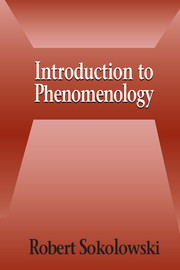Book contents
- Frontmatter
- Contents
- Acknowledgments
- Introduction
- 1 What Is Intentionality, and Why Is It Important?
- 2 Perception of a Cube as a Paradigm of Conscious Experience
- 3 Three Formal Structures in Phenomenology
- 4 An Initial Statement of What Phenomenology Is
- 5 Perception, Memory, and Imagination
- 6 Words, Pictures, and Symbols
- 7 Categorial Intentions and Objects
- 8 Phenomenology of the Self
- 9 Temporality
- 10 The Life World and Intersubjectivity
- 11 Reason, Truth, and Evidence
- 12 Eidetic Intuition
- 13 Phenomenology Defined
- 14 Phenomenology in the Present Historical Context
- Appendix: Phenomenology in the Last One Hundred Years
- Select Bibliography
- Index
7 - Categorial Intentions and Objects
Published online by Cambridge University Press: 05 June 2012
- Frontmatter
- Contents
- Acknowledgments
- Introduction
- 1 What Is Intentionality, and Why Is It Important?
- 2 Perception of a Cube as a Paradigm of Conscious Experience
- 3 Three Formal Structures in Phenomenology
- 4 An Initial Statement of What Phenomenology Is
- 5 Perception, Memory, and Imagination
- 6 Words, Pictures, and Symbols
- 7 Categorial Intentions and Objects
- 8 Phenomenology of the Self
- 9 Temporality
- 10 The Life World and Intersubjectivity
- 11 Reason, Truth, and Evidence
- 12 Eidetic Intuition
- 13 Phenomenology Defined
- 14 Phenomenology in the Present Historical Context
- Appendix: Phenomenology in the Last One Hundred Years
- Select Bibliography
- Index
Summary
The kinds of intentionality we explored in Chapters 5 and 6 were rather colorful and concrete. We examined imagination, picturing, memory, and other familiar elements in our experience. In this chapter we will move to a kind of intentionality that is more austere and more purely rational. We will examine what phenomenology calls categorial intentionality. This is the kind of intending that articulates states of affairs and propositions, the kind that functions when we predicate, relate, collect, and introduce logical operations into what we experience. We will examine the difference, for example, between simply intending an object and making a judgment about that object.
We recall that the word “categorial” is related to the Greek term katēgoreō, which originally meant the act of denouncing or accusing someone, of stating publicly that some feature belongs to him, that he is a murderer or a thief. In philosophy, the term came to mean the act of saying something about something. The phenomenological term “categorial” draws on this etymology. It refers to the kind of intending that articulates an object, the kind that introduces syntax into what we experience. A house is a simple object, but the fact that the house is white is a categorial object. The meaning of the term “Fido” or “dog” is a simple meaning, but the sense of “Fido is hungry” or “Dogs are domesticated” is categorial. When we move to the categorial domain, we move from simple, “one-rayed” intentions to complex, “many-rayed” intentions.
- Type
- Chapter
- Information
- Introduction to Phenomenology , pp. 88 - 111Publisher: Cambridge University PressPrint publication year: 1999



